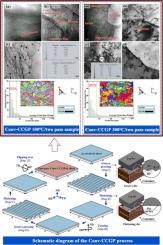用热波纹约束槽压制协同提高6061铝合金的强度和塑性
IF 6.3
2区 材料科学
Q2 CHEMISTRY, PHYSICAL
引用次数: 0
摘要
在这项研究中,对退火的 6061 铝合金进行了 100-300 ℃ 的多道传统波纹约束沟槽压制(Conv-CCGP)变形。Conv-CCGP 变形导致了晶粒细化。合金在 100 ℃/两次变形后,最小晶粒尺寸从 37.4 微米细化到 23.0 微米。电子背散射衍射和透射电子显微镜(TEM)用于分析微观结构和位错模式的演变。结果表明,微观结构的演变在 100 ℃ 和 200 ℃ 受动态复原的支配,而晶粒细化在 300 ℃ 受动态再结晶的支配。TEM 分析表明,在较低温度下,高密度位错呈现长而直的分布。随着温度的升高,不规则排列的位错逐渐减少,演变成具有鱼骨状或交织网状的规则子结构。Mg2Si 和含铁相将位错排成直线,从而提高了合金的强度。在不同温度下,沿轧制方向的极限拉伸强度(UTS)和屈服强度(YS)都有一定程度的提高,而伸长率则有所下降。合金在较低温度下的强化效果更强。经过 100 ℃/four-pass Conv-CCGP 工艺后,合金的 YS 从 52.9 MPa 增加到 124.7 MPa(增加了 135.7%),而伸长率则下降了 71.9%。较高的温度有利于提高合金的塑性。在 300 ℃/one-pass 条件下,Conv-CCGPed 合金的 YS 增加了 38.4%,塑性高达 22.1%。拉伸断裂面分析结果表明,Conv-CCGPed 合金发生了塑性断裂,但断裂模式从拉伸断裂过渡到了剪切断裂。本文章由计算机程序翻译,如有差异,请以英文原文为准。

Synergistically enhanced strength and plasticity of a 6061 aluminum alloy using hot corrugated constrained groove pressing
In this study, the annealed 6061 aluminum alloy was subjected to multi-pass conventional corrugated constrained groove pressing (Conv-CCGP) deformation at 100–300 ℃. The Conv-CCGP deformation led to grain refinement. After the alloy was deformed at 100 ℃/ two-pass, the minimum grain size was refined from 37.4 to 23.0 μm. Electron backscattered diffraction and transmission electron microscopy (TEM) were used to analyze the evolution of microstructure and dislocation patterns. Results showed that the evolution of microstructure at 100 and 200 ℃ was governed by dynamic recovery, whereas grain refinement was dominated by dynamic recrystallization at 300 ℃. TEM analysis revealed that high-density dislocations exhibited a long and straight distribution at lower temperatures. As the temperature increased, irregularly arranged dislocations decreased, evolving into regular substructures with fishbone-like or interwoven network-like shapes. The Mg2Si and iron-containing phases pined dislocations, thus improving the strength of the alloys. The ultimate tensile strength (UTS) and yield strength (YS) along the rolling direction increased to some extent at different temperatures, whereas the elongation decreased. The strengthening effect of the alloy was stronger at lower temperatures. The YS of the alloy increased from 52.9 MPa to 124.7 MPa (135.7 % increase) after the 100 ℃/four-pass Conv-CCGP process, while elongation decreased by 71.9 %. Higher temperatures are beneficial for improving the plasticity of the alloy. The YS of the Conv-CCGPed alloy at 300 ℃/one-pass increased by 38.4 % with a high plasticity of 22.1 %. The tensile fracture surface analysis results showed that the Conv-CCGPed alloy underwent plastic fracture, but the fracture mode transitioned from tensile fracture to shear fracture.
求助全文
通过发布文献求助,成功后即可免费获取论文全文。
去求助
来源期刊

Journal of Alloys and Compounds
工程技术-材料科学:综合
CiteScore
11.10
自引率
14.50%
发文量
5146
审稿时长
67 days
期刊介绍:
The Journal of Alloys and Compounds is intended to serve as an international medium for the publication of work on solid materials comprising compounds as well as alloys. Its great strength lies in the diversity of discipline which it encompasses, drawing together results from materials science, solid-state chemistry and physics.
 求助内容:
求助内容: 应助结果提醒方式:
应助结果提醒方式:


